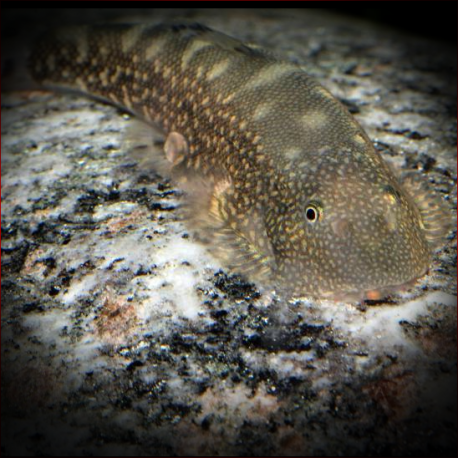More info
Datasheet
| Minimum Tank Size | 60 litres / 15.85 US gallons |
| Maximum Size | 4.0cm / 1.57inches |
| Temperature | 20°C / 68.00°F - 24°C / 75.20°F |
| Hardness | 1.01dgH / 18ppm - 12.05dgH / 215ppm |
| pH | 6.0-7.5 |
General Description
Gastromyzon Farragus, a member of the Gastromyzontidae family under the Cypriniformes classification order, is a peaceful fish with a maximum size of approximately 4.0cm. It is commonly known as the "Borneo sucker" and is dark brown in color with thin cream bars on its dorsal surface, spots and blotches on its flank, a red caudal fin, and specific physical features that distinguish it from other species in its genus.
Aquarium Setup
The ideal aquarium setup for Gastromyzon Farragus includes a clean, well-oxygenated environment with an oversized filter for high turnover, gravel or sand substrate with rocks and pebbles, aged driftwood, and possibly aquatic plants like Microsorum and Anubias. It requires stable water conditions within a pH range of 6.0-7.5, a temperature of 20-24°C, and a hardness level of 18-215ppm. Regular water changes are crucial, and the presence of biofilm for grazing is essential.
Behaviour
Gastromyzon Farragus exhibits peaceful behavior but may display territorial tendencies, with some individuals being more protective of their space. They are known to exist in loose aggregations and should be kept in groups of four or more to observe their most interesting behavior. Suitable tankmates include small, pelagic cyprinids, certain gobies, rheophilic catfishes, and select loaches, but aggressive or much larger fish should be avoided.
Feeding and Diet
In the wild, Gastromyzon Farragus feeds on benthic algae and micro-organisms. In captivity, they accept dried foods, live or frozen bloodworms, and home-made diets rich in fresh vegetables and Spirulina. Algae-covered surfaces are essential for their long-term health, and maintaining a source of suitable foods is vital, especially for emaciated specimens commonly found in the trade.
Reproduction & Dimorphism
Breeding Gastromyzon Farragus in captivity is rare, with limited documented cases. Observations suggest that successful breeding involves specific conditions, including temperature fluctuations and optimal food availability. Adult females tend to be heavier-bodied and slightly larger than males, with these differences more noticeable when viewed from above or below.
Habitat and Distribution
Restricted to tributaries of the Sadong River basin in southern Sarawak, Malaysian Borneo, Gastromyzon Farragus and other Gastromyzon spp. are endemic to Borneo. They inhabit swift, shallow streams with clear, oxygen-rich water, commonly found in riffles and runs above or below cascades and waterfalls. Their specialized morphology allows them to cling to solid surfaces in fast-flowing water, where they forage and maintain their position within the stream ecosystem.

